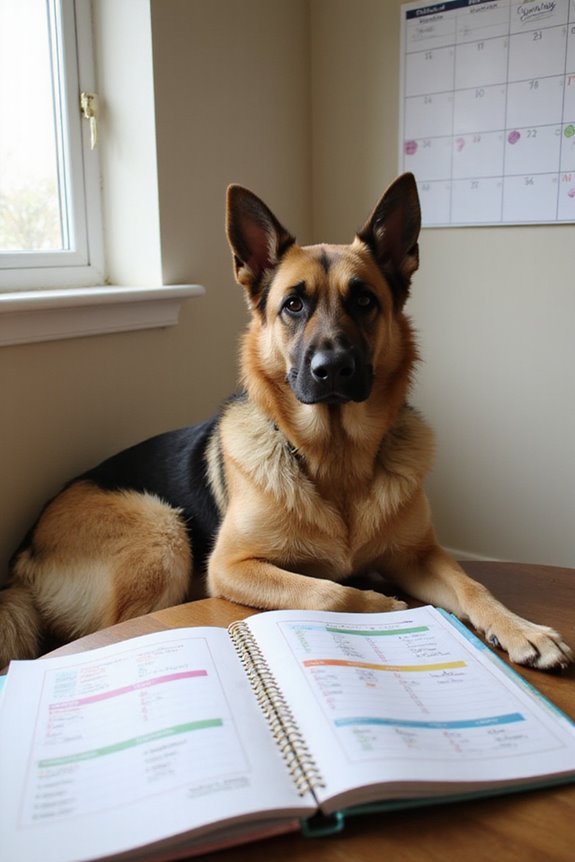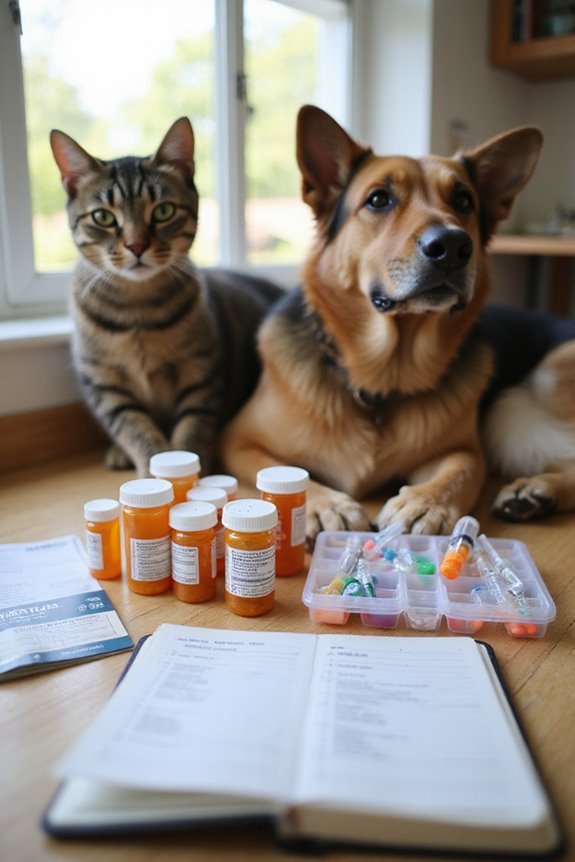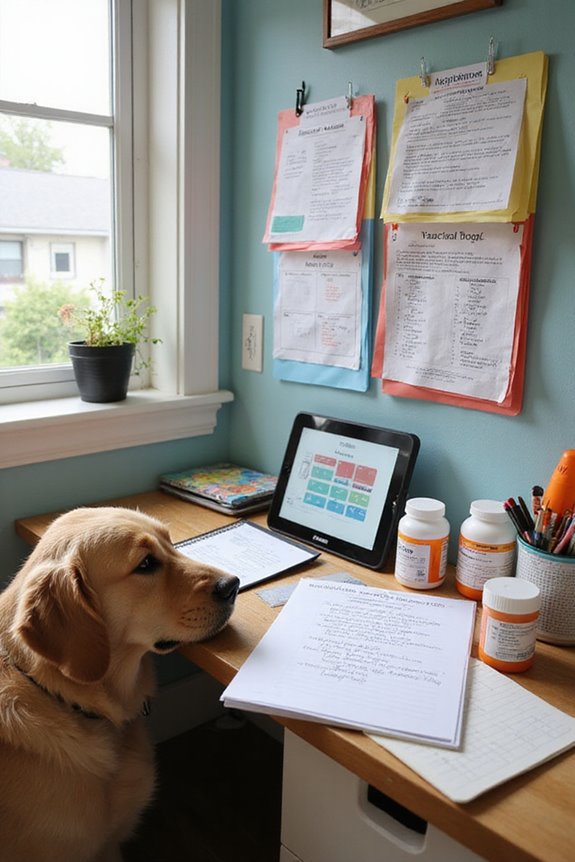Managing veterinary care for multiple pets involves careful organization and proactive planning. I recommend scheduling regular wellness exams for each pet according to their age and health needs, ideally annually for adults and semi-annually for seniors. To control costs, track expenses, set an emergency fund, and explore wellness plans. Keep detailed health records on a centralized platform and consider telemedicine options. By focusing on preventive care, I can minimize emergency costs. Continue to discover effective strategies for managing your pets’ health needs.
Key Takeaways
- Utilize a centralized record system to keep track of all pets’ medical histories and appointments in one place for easy reference.
- Schedule concurrent wellness exams for all pets to maximize convenience and streamline vet visits.
- Set a budget and maintain an emergency fund specifically for veterinary expenses to manage costs effectively.
- Leverage technology for automated reminders and communication tools to enhance adherence to medical advice and appointments.
- Explore local community programs for support, such as workshops, financial assistance, and disease prevention resources tailored for multiple pets.
Understanding the Increased Need for Veterinary Care
As pet ownership rises, understanding the increased need for veterinary care becomes essential. With approximately 59.8 million U.S. households owning dogs and about 42.2 million owning cats, the demand for veterinary services is at an all-time high. The dog population alone surged from 52.9 million to 89.7 million in nearly three decades, creating substantial veterinary service demand.
This escalating trend means more pets require attention, leading to increased caseload complexity. Many clinics report strain, managing diverse health needs stemming from varied species and breeds. Additionally, nearly 28% of pet owners face financial barriers to accessing care. Consequently, understanding these dynamics is vital for owners to effectively plan for their pets’ medical needs and for clinics to manage patient loads efficiently.
Scheduling Regular Wellness Exams for Each Pet

Scheduling regular wellness exams for each of your pets is essential for maintaining their overall health and well-being. To establish effective scheduling strategies, consider the following recommendations:
- Puppies and Kittens: Schedule exams every 3 to 4 weeks until they reach about 16 to 20 weeks old.
- Adult Pets: Aim for at least one wellness exam annually, adjusting based on breed and health status.
- Senior Pets: Plan for semi-annual exams to monitor age-related health issues.
Efficiently Managing Veterinary Costs

Managing veterinary costs can be a significant challenge for pet owners, especially as prices continue to rise. To navigate this financial landscape, I recommend effective budgeting strategies that really help. Start by tracking your pet care expenses meticulously; this will highlight necessary areas for adjustment.
Consider setting aside an emergency fund specifically for veterinary needs. Comparing costs between local veterinarians helps too; some offer lower-cost alternatives or flexible payment plans.
Also, inquire about wellness plans or bundled services to spread costs over time, ensuring proper care without financial strain. Remember, investing time in these strategies can lead to better health outcomes for your pets while making overall care more manageable.
Overcoming Barriers to Accessing Veterinary Care

Accessing veterinary care can be hindered by a range of barriers that affect pet owners across diverse communities. Geographic barriers, like distance to clinics or transportation difficulties, can make it challenging to seek help. Economic challenges often arise, as many pet owners struggle to afford care, even if clinics are nearby. Communication issues, particularly with language and cultural perceptions, can lead to misunderstandings and reduced trust. Psychological factors may also prevent pet owners from seeking necessary services due to fear or past trauma. To overcome these barriers, it’s essential to explore accessibility solutions, like telemedicine, financial assistance programs, and inclusive communication strategies that foster trust and understanding in veterinary care.
Keeping Detailed Health Records for Multiple Pets

Maintaining detailed health records for multiple pets is essential, especially when considering the varied medical needs each animal may have. I find that proper record organization can truly make a difference in managing their healthcare. Here’s how I do it:
- Individual Records: I keep separate records for each pet, avoiding any confusion.
- Consistent Format: I use a standardized format for vaccinations, surgeries, and medications.
- Chronological Order: Organizing records by visit date enhances quick reference.
- Prompt Documentation: I record clinical notes immediately after appointments to guarantee accuracy.
Utilizing digital management tools makes this process easier. By leveraging veterinary software or apps, I can sync records across platforms, making them accessible for family members involved in my pets’ care. This level of organization fosters better healthcare decisions.
Utilizing Technology for Medical Coordination
Coordinating veterinary care for multiple pets can be complex, particularly with their varied needs. Utilizing digital health technologies, specifically veterinary software, can notably streamline this process. These centralized platforms offer several benefits:
- Centralized Records: Manage multiple pets’ medical histories in one place, reducing fragmented data.
- Streamlined Scheduling: Automated reminders guarantee appointments and treatments aren’t missed.
- Communication Tools: SMS or email notifications improve adherence to medical advice.
- Integration: Access to integrated health records allows for quick, accurate consultations.
- AI Assistance: Automate administrative tasks, like SOAP notes, decreasing errors.
Supporting Stress-Free Veterinary Visits
To guarantee veterinary visits are as stress-free as possible for both you and your pets, it’s essential to prepare them adequately for the experience. Here’s how you can support a calm visit:
- Desensitizing Handling: Practice gentle handling at home. Mimic vet scenarios, using treats to build positive associations. Gradually increase handling duration.
- Familiarization with Carriers: Keep carriers accessible. Place toys and treats inside to create comfort. Feed pets in their carriers and take short, pleasant car rides.
- Optimizing the Veterinary Environment: Choose clinics with Fear Free® protocols, minimize noise, and prefer ground-level examinations. Request wait-in-car options to avoid crowd anxiety.
- Utilizing “Happy Visits”: Schedule non-medical visits for exploration, bringing treats and toys to create rewarding experiences.
Prioritizing Preventive Care to Minimize Emergency Costs
Preventive care fundamentally shapes the health trajectory of our pets, greatly reducing the likelihood of emergencies that can lead to costly treatments. By prioritizing regular veterinary visits, we guarantee our pets receive essential preventive vaccinations and effective parasite control. These practices can considerably decrease the risk of infectious diseases and complications stemming from parasites like fleas and ticks.
Key aspects of preventive care include:
- Regular Check-ups: Early detection of potential health issues.
- Vaccination Protocols: Tailored for each pet, minimizing risk.
- Parasite Prevention: Proactively using appropriate products to limit infestations.
Exploring Pet Insurance and Discounts for Multiple Pets
As I investigate the complexities of managing veterinary care for multiple pets, one significant consideration is exploring pet insurance options. Many insurance companies offer multi-pet discounts, typically ranging from 5–10% off premiums for additional pets. This can apply whether you’re purchasing multiple policies at once or adding a new pet to an existing plan.
I appreciate the flexibility of insurance customization; I can choose between covering all pets under one extensive plan or obtaining separate policies tailored to each pet’s specific needs. This not only simplifies billing but also helps manage emergency care and routine expenses more effectively. It’s crucial to compare quotes and understand the coverage options for each pet’s unique health profile to guarantee ideal care while keeping costs manageable.
Advocating for Responsible Pet Ownership and Animal Welfare
Advocating for responsible pet ownership and animal welfare is essential, especially in households with multiple pets. By educating ourselves about the needs of our furry companions, we can prevent neglect and guarantee their happiness. Here are some key considerations:
- Nutrition and Care: Understanding specific dietary and health needs reduces risks.
- Spaying/Neutering: This helps control overpopulation, reducing shelter intakes.
- Behavior Awareness: Recognizing body language minimizes conflicts.
- Community Resources: Utilize local programs for disease prevention and health education.
Promoting animal welfare is not just about policies and legislation but also about individual responsibility. By adopting ethically, supporting shelters, and guaranteeing our pets’ well-being, we contribute to a better quality of life for our pets and a healthier environment for all. Additionally, ensuring that pets receive year-round heartworm prevention is crucial for their long-term health and safety.
Frequently Asked Questions
How Can I Choose the Best Veterinarian for Multiple Pets?
Choosing the right vet for my pets, I consider their qualifications and experience with various species. I also weigh my pet insurance options, ensuring extensive coverage for all my furry family members during visits.
What Should I Do if My Pet Is Afraid of the Vet?
Imagine my trembling pup, eyes wide with fear at the vet. I’ve learned calming techniques and effective fear management strategies, transforming those visits into something more positive and reassuring. It’s made a world of difference for us.
How Often Should I Update My Pets’ Health Records?
I update my pets’ health records immediately after any visit or change in their condition. Good record keeping helps me with health tracking, ensuring I never miss essential details and keeping their care organized and effective.
Can I Combine Wellness Visits With Other Appointments?
Last week, I combined my dog’s wellness appointment with her brother’s check-up, and it worked wonders! Appointment scheduling became seamless, easing my stress and ensuring both pets received thorough care in one visit.
What Should I Do in Case of a Veterinary Emergency?
In a veterinary emergency, I immediately assess my pet’s condition and apply first aid techniques. I’ve prepared ahead by knowing the nearest vet, ensuring I’m ready for any crisis. Calmness makes all the difference.


